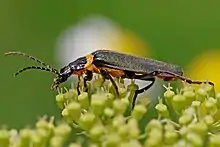Soldier beetle
The soldier beetles (Cantharidae) are relatively soft-bodied, straight-sided beetles. They are cosmopolitan in distribution. One of the first described species has a color pattern reminiscent of the red coats of early British soldiers, hence the common name. They are also known commonly as leatherwings because of their soft elytra.[1]
| Soldier beetle Temporal range: | |
|---|---|
 | |
| Chauliognathus lugubris | |
| Scientific classification | |
| Domain: | Eukaryota |
| Kingdom: | Animalia |
| Phylum: | Arthropoda |
| Class: | Insecta |
| Order: | Coleoptera |
| Suborder: | Polyphaga |
| Infraorder: | Elateriformia |
| Superfamily: | Elateroidea |
| Family: | Cantharidae Imhoff, 1856 |
| Synonyms | |
|
Chauliognathidae | |
Historically, these beetles were placed in a superfamily "Cantharoidea", which has been subsumed by the superfamily Elateroidea; the name is still sometimes used as a rankless grouping, including the families Cantharidae, Lampyridae, Lycidae, Omethidae (which includes Telegeusidae), Phengodidae, and Rhagophthalmidae.
Soldier beetles often feed on both nectar and pollen as well as predating other small insects. The larvae are often active, velvety, often brightly colored, and they feed on the ground, hunting snails and other small creatures.
Evolutionary history
The oldest described member of the family is Molliberus from the Early Cretaceous (early Albian) aged El Soplao amber from Cantabria, Spain, belonging to the tribe Cantharini in the subfamily Cantharinae. Other described genera include 6 from the early Late Cretaceous (early Cenomanian) aged Burmese amber, with 5 belonging to Cantharinae and one to Malthininae, and Katyacantharis, from the Cenomanian aged Agdzhakend amber of Azerbaijan, suggested to belong to Cantharinae. Indeterminate specimens have been reported from the Aptian aged Koonwarra fossil bed of the Strzelecki Group, Australia and the Barremian aged Lebanese amber.[2][3]
Subfamilies, tribes and selected genera
Five subfamilies are normally accepted:
Cantharinae
- tribe Cantharini
- tribe Podabrini
Chauliognathinae
- tribe Chauliognathini
- tribe Ichtyurini
Dysmorphocerinae
- Afronycha Wittmer, 1949 - central-southern Africa
- Asilis Broun, 1893 - New Zealand
- Compsonycha
- Dysmorphocerus Solier, 1849
- Flabelloontelus
- Geigyella Wittmer, 1972 - New Guinea
- Hansasilis
- Heteromastix Boheman, 1858 - Australia
- Hyponotum
- Micronotum
- Neoontelus Wittmer, 1972 - New Zealand
- Oontelus Solier, 1849 - S. America
- Plectocephalon
- Plectonotum Gorham, 1891 - Americas
Malthininae
- tribe Malchinini
- Macrocerus Motschulsky, 1845 - Europe (synonym Malchinus)
- tribe Malthinini
- Caccodes Sharp, 1885 - Central America, Pacific islands
- Malthinellus Kiesenwetter, 1874 - Japan
- Malthinus Latreille, 1805 - Japan, Europe, N. America
- tribe Malthodini
Silinae
- tribe Silini
- Cordylocera Guérin-Méneville, 1830
- Silis Charpentier, 1825
- tribe Tytthonyxini
- Tytthonyx LeConte, 1851
Reproduction
Large males of the soldier beetle exercise choice for larger females. Body size correlates with the abilities of males to secure females, and of females to evade males.[4]
See also
References
- Phillips, C., et al. Leatherwing (Soldier) Beetles. Virginia Cooperative Extension, Virginia Tech and Virginia State University. 2013.
- Peris, David; Fanti, Fabrizio (November 2018). "Molliberus albae gen. et sp. nov., the oldest Laurasian soldier beetle (Coleoptera: Cantharidae) from the Lower Cretaceous Spanish amber". Cretaceous Research. 91: 263–268. doi:10.1016/j.cretres.2018.07.003. S2CID 134003163.
- Kazantsev, Sergey V.; Perkovsky, Evgeny E. (2019-02-28). "The first Cretaceous beetle from Azerbaijan: Katyacantharis zherikhini gen. et sp. n. (Coleoptera, Cantharidae) from Cenomanian Agdzhakend amber". Palaeoentomology. 2 (1): 7. doi:10.11646/palaeoentomology.2.1.2. ISSN 2624-2834. S2CID 86634741.
- McLain, Denson K.; Pratt, Ann E.; Shure, Donald J. (June 2015). "Size dependence of courtship effort may promote male choice and strong assortative mating in soldier beetles". Behavioral Ecology and Sociobiology. 69 (6): 883–894. doi:10.1007/s00265-015-1900-6. ISSN 0340-5443. S2CID 253810679.
External links
- Delta key
- Keys for the identification of British Cantharidae
 Media related to Cantharidae at Wikimedia Commons
Media related to Cantharidae at Wikimedia Commons Data related to Cantharidae at Wikispecies
Data related to Cantharidae at Wikispecies